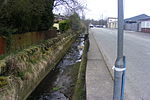2012 Oldham explosion
2010s in Greater Manchester2012 disasters in the United Kingdom2012 in England2012 industrial disastersDisasters in Greater Manchester ... and 6 more
English history stubsEngvarB from August 2019Explosions in EnglandHistory of the Metropolitan Borough of OldhamJune 2012 events in the United KingdomShaw and Crompton

The 2012 Oldham explosion occurred on 26 June 2012. A house on Buckley Street in Shaw, a town in the Metropolitan Borough of Oldham, England exploded at 10:40am. Twelve neighbouring homes were destroyed in the blast amounting to £1.2m of damage. 175 homes were evacuated. 30 firefighters were at the site of the blast. A two-year-old boy was killed and one man injured. A gas leak was reported before the explosion. The two-year-old was later named as Jamie Heaton and the man as Jamie's neighbour; 27-year-old Andrew Partington.
Excerpt from the Wikipedia article 2012 Oldham explosion (License: CC BY-SA 3.0, Authors, Images).2012 Oldham explosion
Chancery Lane,
Geographical coordinates (GPS) Address Nearby Places Show on map
Geographical coordinates (GPS)
| Latitude | Longitude |
|---|---|
| N 53.58021 ° | E -2.0909 ° |
Address
Chancery Lane
Chancery Lane
OL2 8EX , Wood End
England, United Kingdom
Open on Google Maps







